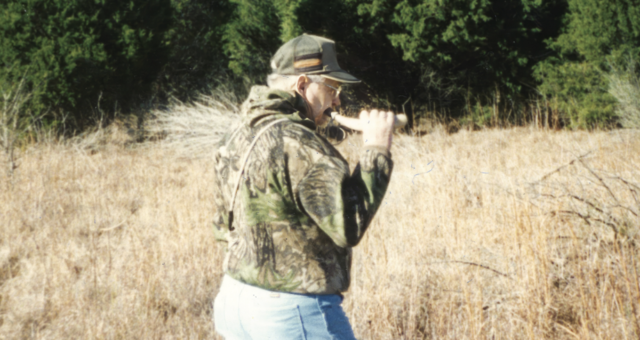by Kelly Reeves
Communication is and always has been, an important part of any society. In 2024, long-distance communication is simple.
Cell phones enable us to make contact with whoever we want, whenever we want, and wherever we currently may be. But, it hasn’t always been so simple. In just the last 50 some-odd years, we have gone from the land-line telephone, wireless pagers, walkie-talkies, CB and two-way radios, and now to smart phones that enable you to have live audio and video communications at your fingertips wherever you may be. This is amazing considering that not long before, humans were using carrier pigeons, drum beats, smoke signals, and bugles to send messages. During the same early time period, many hunters fashioned their own means of communication, the blowing horn.
As a kid, my great uncle Dave Olive gave me a pair of beagle puppies. The pups were field champion sired littermates, a male named O-Line General Lee, and a female named O-Line Dixie. At that time he gave me the first blowing horn I had ever seen. It was made from a long goat horn and had a long leather shoulder strap attached. Uncle Dave spent some time with me and taught me how to blow the horn and make a beautiful tenor sound with it. He told me to blow a series of notes as I came to feed the pups each day. I did as he told me and before long the General and Dixie learned that the horn meant supper was on the table and they would come running upon hearing the feed time cadence.
Hunting horns are basically hand-made musical instruments that were used to relay messages. Throughout history, similar horns were used in biblical times, in ancient Rome, and on the battlefield worldwide before bugles were common. They were used by early settlers as a means to call workers in from the fields at meal times, and to announce town meetings and church services before bells were common. They are most recognized during the classic English fox hunts when horseback houndsmen used their horns to signal the hounds and other hunters. Houndsmen and hunters of all types used these horns to communicate over great distances because each horn had its own tone, and each tone could be attributed to a particular hunter, much like recognizing a voice. The hunters used a particular cadence, or a particular series of short and long notes to relay a certain message. The sound of the horns carried a great distance with ease and kept the hunters informed as to the progress of the hunt. Under the right conditions, a well-blown horn can be heard much further than a mile.
Traditional English fox hunters had their own vocabulary when using the blowing horn during a hunt. The hunt began with the Moving Off signal blown by the huntsman. The huntsman controlled the hunt while the “whippers-in” assisted him.
The Moving Off was a quick, sharp double note that signaled the start of a hunt. The hounds and hunters heard the signal and all knew the hunt was underway.
Drawing calls were quick, light, soft volume notes of the horn used sparingly to let the hounds searching for scent keep track of the location of the huntsman. It was used to keep the working hounds and whippers-in moving in the same general direction as the huntsman when distance prevented them from visually seeing each other.
Blowing Out is a long, sorrowful sounding wail that is repeated several times in a series. It is used when the huntsman decides to gather and move the hounds to another location to continue the hunt. Usually used due to no game being found in the immediate area. The same call is used any time the hounds need to be gathered in.
Doubling The Horn is used as a “Tally-Ho” call. It is a fast, excited series of short staccato notes used to signal to the hounds and hunters that the quarry has been seen or jumped up, and to call the hounds to the chase.
Gone To Ground is a long wavering, sad sounding note repeated three times. It signals that the game has eluded the hounds and gone into a hole or den. The series may end with a tremelo which is made by shaking the mouthpiece of the horn against the lips.
Blowing For Home is a long, mournful wail blown to signal the end of the hunt. This extended tone calls the dogs back to the huntsman in preparation for the trip home. There are many more notes with many different meanings but this gives you an idea of the language.
As American fox hunters and beaglers, we used a similar series of notes while running our hounds. An excited series of short notes was used to call “Tally-Ho” when a rabbit was jumped. A different series of notes was used to call the hounds after the hunt. The hunters and hounds knew the language, and the voice of the horn could be heard for a very long distance.
The blowing horns weren’t only used when hunting with hounds. They had a place in other hunting situations, also. As youngsters deer hunting in the huge national forests, we would be taken to our stand by the older men and dropped off to hunt until dark. Each hunter carried his own blowing horn. We knew that if we killed a deer and needed help dragging it out, became injured, or needed them to come to us for whatever reason, we could blow a long and two short notes to let the adults know our situation. One of them would answer with the reverse, two short notes, and a long note, to acknowledge that he got the message and is coming. After waiting 15 or 20 minutes, we would blow the series again and listen for the adult to answer. This allowed each of us and the others within earshot, to know the other’s progress and present location. It was a good feeling to hear the older hunter closing the distance and getting closer. If no problems occurred and no kill was made, the youngsters walked out of the woods alone. One of the men who arrived back to the truck or camp first would blow two long notes on his horn every fifteen minutes or so. The hunters on foot would answer with one long note. This call allowed the young hunters to walk toward the sound of the horn to get back by the most direct route and allowed the adults to hear the progress of the youngsters and keep track of their location until their arrival.
The blowing horns were handmade from the horns of cows, or goats for the most part. Sheep horns were sometimes used. Early blowing horns were built in a somewhat crude fashion as aesthetics weren’t considered an important factor to many hunters. On the other hand, some were made very intricately with the maker leaving his personal touches to shine. Many were engraved with hunting scenes or the makers mark. Many were polished to a high gloss shine. All of the good ones were tuned to a clear tone. Houndsmen took pride in carrying a horn that was both functional and beautiful.
A blowing horn can only sound one single note unique to that particular horn. Even the matching horn from the same animal had a different tone than its mate. Although the horn can only sound one note, that note can be altered and refined during the process of making the horn. Trimming length from the bell end, and experimenting with the size of the hole in the mouthpiece will change the tone of the horn.
Blowing horns were available for purchase from the hound hunter’s supply stores but the quality was sorely lacking. They were mass-produced in India and other places around the globe. They looked poorly, felt bad, and sounded worse. Many hunters made their blowing horns or tried to barter for a custom-made horn from one of the well known horn makers. There were two horn makers in particular in the south who were exceptionally good at their craft and were famous among houndsmen for the quality of the horns each made. Cotton Fite of Grand Saline, Texas, and Nalda Gilmore from West Monroe, Louisiana were well known for crafting high-quality blowing horns. Both men made beautiful hand crafted blowing horns that were desired for the lovely tones their horns produced. If a hunter owned a horn made by either of these men, he treasured it as a prized possession. These horns were always passed down from generation to generation and kept as a family treasure, now adorning the wall of a great-grandchild. Cotton Fite and Nalda Gilmore were also well known for their prowess at blowing their horns. Cotton was known to blow two horns at once, one on each corner of his lips. Both of these men lived their lives to the fullest but are now gone, and few of their beautiful horns are still in use. Cotton Fite could still blow a horn at 100 years of age, though he stopped making them long before then. Nalda Gilmore taught his children to make the blowing horns and one of his daughters is still making them to this day. Her horns can be seen and purchased at G&G Handmade Hunting Horns on Facebook.
Blowing a horn is not difficult but it does take some practice. As with most skills, practice improves performance. Most anyone could quickly learn to successfully blow a note on the horn but those who were more experienced could make that note a thing of beauty. The hunter must tighten his lips against his teeth, press the mouthpiece of the horn against his lips, and blow a steady stream of air into the mouthpiece. The vibration of the lips against the mouthpiece makes the sound. Then, the tone is refined by varying the pressure of the horn against the lips, and the air pressure blown into the horn. Tapping the tongue against the mouthpiece to stop the airflow will make the short notes. Unlike a trumpet or bugle player who places the mouthpiece in the center of their lips, most hunters blew their horns from the corner of their lips.
True enough, a blowing horn is no longer a necessity around the hunting camps and farms. It has become another obsolete tool outdated by evergrowing technology. Need one or not, I still pick mine up every once in a while, dust them off, and blow them. The feel and the sound of each one brings back a wave of memories and for just a little bit, I get to enjoy the thoughts of old friends, old dogs, and hunts that can never be repeated.












